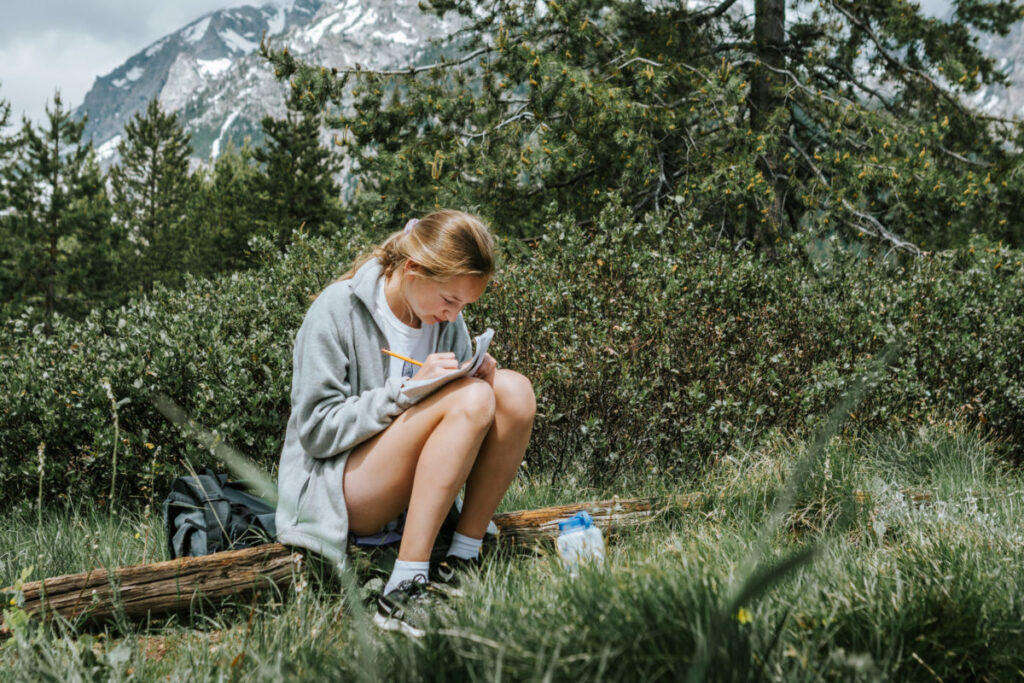 Age Range & Audience: This sensory activity is great for any age, andcan be done together or alone. A few modifications and extensions are offered below.
Age Range & Audience: This sensory activity is great for any age, andcan be done together or alone. A few modifications and extensions are offered below.
Materials: Journal, notebook or piece of paper, pen, colored pencils, crayons, or other materials for drawing or coloring (all optional)
Lesson Overview: Amidst the busy cadence of our lives, it can be hard to find the time to slow
down and connect to the natural world around us. “Sit spots” are places we can go to sit quietly, observe, and reflect – paying careful attention to any sights, sounds, smells and feelings we notice while there. Sit spots do not have to be grand places – they can be anywhere a bit of nature is present: a park bench, rocks along a local creek, the branch of a favorite tree, a balcony, a backyard. Over time, sit spots can become special places that we find ourselves returning to repeatedly. They can also become places we connect to deeply and where we might notice and track changes in nearby flora or fauna, pick up on different patterns or activities, or observe how weather affects our mood on a given day or time.
Connections to:
Place-based Education Principles: Learner-centered, community as classroom, interdisciplinary approach, inquiry-based
Cross Cutting Concepts in Next Generation Science Standards: Patterns, Stability and Change
Social Emotional Learning: By spending repeated time in a place, we start to develop an emotional connection to that spot, and the place we are in begins to take on new meaning. Doing an activity like this with regularity can also deepen our relationship with nature as a whole. In this sense, regular immersion in our surroundings helps the Earth to flourish, as well as ourselves. As we develop our understanding of nature and place, we also increase our ability to speak knowledgeably and passionately on its behalf.
Learning Outcomes:
- Increase curiosity and connection to the natural world and to self through sensory exploration
- Identify patterns in surroundings to form observations, questions and connections
- Engage with the first steps of the scientific process
Download the PDF Version of the Lesson
Lesson Activity:
Find your sit spot: This spot should be at least 10 feet from others if you are doing this activity with someone else, and should be a place where you can be still and quiet on your own, observing what is going on around you with relatively little distraction. We recommend bringing a journal or piece of paper and writing utensil with you in case there is something that catches your attention that you want to record.
Settle into your special spot: Set your watch for 10 minutes. Begin by closing your eyes and taking three, full deep belly breaths to let go of anything that might be presently on your mind. Land fully in the moment.
Engage your senses: Start to focus on each of your six senses individually – first your sense of vision, then smell, hearing, touching, feeling. (Only engage your sense of taste if it is safe and appropriate to do so!). Use a few of the sensory prompts below to help guide this process and provide a little structure to this full sensory experience of noticing and wondering at what is around you.
Record your observations: If you have journaling materials with you, record all of the “daily happenings” that you notice, paying particular attention to any plants, animals, weather, or activities happening around you. Record any questions that you have. Focus on your own thoughts and feelings, and make note of these in your journal as well.
Share what you noticed and wondered: After 10 minutes are up, return from your sit spot and share what you noticed and what the activity made you feel with someone special. If you asked any questions during your sit spot, take a few minutes to look for answers – perhaps from a knowledgeable friend, family member, mentor, or another resource such as a field guide.
Return to your sit spot again: Don’t forget where your sit spot is, because you may want to return there again in the next day or week(s) to note what has changed and what has stayed the same!
Sensory Prompts
Sight: Even if your sit spot is a familiar place to you, take a few moments to really look around. What do you see that perhaps you didn’t notice before? Are there any details that you can “zoom in on” and look really closely at? Try focusing on a single color around you – how many shades of green or brown or red can you count? Create a list of what you see and what activities are going on – whether you notice trees, flowers, leaves, bricks, buildings, or a dog chasing after its favorite ball.
 Sound: Listen closely for any sounds – human or natural – make note of these in your journal. Who, or what is making them? Turn your head in the direction of the sounds. Try using deer ears to amplify what you hear, creating a cup shape with your hands and placing one cupped hand around and behind each ear. Do the sounds get louder? Turn your deer ears around so the cup is facing behind you. What happens to the sounds then? Close your eyes and try capturing a handful of sounds, noting with a finger each time you hear a new sound until you have collected 5 sounds in your hand. Create a sound map in your journal. Draw an X in your journal to mark your sit spot. Then listen intently to any noises around you and note these sounds on the page in relation to where you are sitting.
Sound: Listen closely for any sounds – human or natural – make note of these in your journal. Who, or what is making them? Turn your head in the direction of the sounds. Try using deer ears to amplify what you hear, creating a cup shape with your hands and placing one cupped hand around and behind each ear. Do the sounds get louder? Turn your deer ears around so the cup is facing behind you. What happens to the sounds then? Close your eyes and try capturing a handful of sounds, noting with a finger each time you hear a new sound until you have collected 5 sounds in your hand. Create a sound map in your journal. Draw an X in your journal to mark your sit spot. Then listen intently to any noises around you and note these sounds on the page in relation to where you are sitting.
Smell: What do you notice when you inhale and exhale through your nose? What does the air feel like in your nostrils? Put your nose up close to something natural that is near where you are sitting and inhale. What does the smell remind you of? Are there any overwhelming smells that might tell you something of what is going on in your surroundings? Do these smells change over time?
Touch: Place your hands (or perhaps your toes if it’s a warm sunny day and you are barefoot) on the surface where you sit – whether tree or bench or soil. What does it feel like? Squishy? Hard? Cool? Hot? What factors might be contributing to that sensation? Perhaps you are sitting on the earth and can pick up a handful of soil and rub it between your fingers. What does it feel like? (When engaging this sense, try not to disturb anything that is alive and living. Sit spots are really about sitting and being without unnecessary disturbance to nature).
Feeling: What emotions arise as time passes at your sit spot? Are you happy? Nostalgic? Reflective? Sad? How does the practice of taking a few quiet and observant moments to yourself change your mood? You might consider adding a few of these personal reflections in your journal or notebook.
Reflections:
Consider the following prompts as you reflect on on your observation experience (this can be done on your own or with someone else):
• What was it like to sit still and quietly observe your surroundings from one place?
• What feelings arose?
• What did you notice with your senses that surprised you?
• What is something you wondered?
• If you were to return to your sit spot again in the next day, week or month, what do you think would be changed?What ways might you track or record this information so that you have a catalogue of what is going on and what is changing over time?
Age Adaptations:
Younger audiences: Instead of 10 minutes, try 5, and focus on a single and simple prompt to engage each of the senses one at a time. To encourage sharing and reflection after the sit spot activity, frontload with a reminder that each learner will be sharing one thing they noticed or wondered about after those 5 minutes are up.
Older audiences: Increase the amount of time spent at the sit spot. Start with ½ hour. Increase the number of sensory prompts for engaging each of the senses, and consider integrating one or several specific field journaling exercises focused on detailed exploration of one’s surroundings that you can do in one place. Following the sit spot, spend time discussing and reflecting on the value and insights gained from such an intimate, solo experience in nature.
Extensions:
Sit Spot Progressions: If you are able to visit your sit spot multiple times over a period of days or weeks, consider building a progression of sensory or observational prompts that encourage you to focus on different aspects of your surroundings each time, or use the same prompts each time as a guide to track any changes you notice in the plant or animal communities, in the weather, in your mood. Chronicle these changes in your field journal or notebook.


